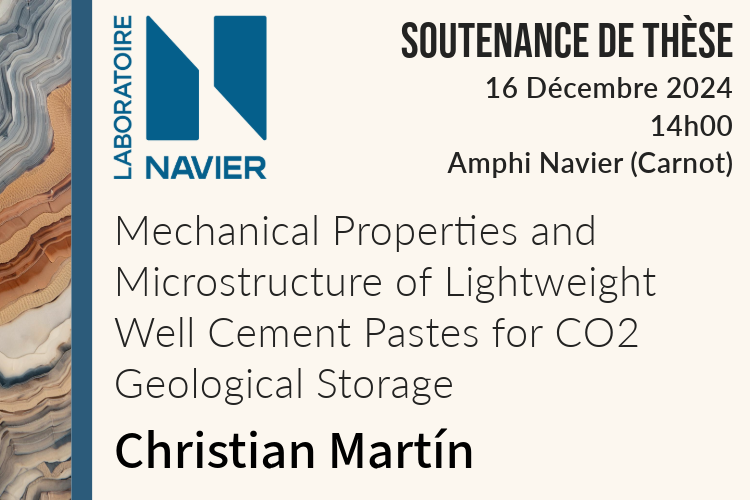
Soutenance de thèse – Christian Martín
- Post by: Mathias Lebihain
- 11 décembre 2024
- No Comment
Christian Martín, doctorant au sein de l’équipes Géotechnique soutiendra sa thèse « Mechanical Properties and Microstructure of Lightweight Well Cement Pastes for CO2 Geological Storage » le lundi 16 décembre à 14h00 dans l’amphithéâtre Navier.
Composition du jury :
- Teddy FEN-CHONG (Université Gustave Eiffel) – Examinateur
- Guido MUSSO (Politecnico di Torino) – Rapporteur
- Antonin FABBRI (ENTPE) – Rapporteur
- María Belén GONZÁLEZ FONTEBOA (Universidade da Coruña) – Examinatrice
- Jean-Michel PEREIRA (ENPC) – Directeur de thèse
- Diego MANZANAL (E.T.S.I. Caminos, Universidad Politécnica de Madrid) – Co-Directeur de thèse
- Teresa PIQUE (YPF Tecnología S.A.) – Invité
- Siavash GHABEZLOO (ENPC) – Invité
La soutenance sera diffusée au lien suivant : https://www.youtube.com/live/Np1YNzuLjdw
Résumé de la thèse
Afficher le résumé
CO2 capture and geological storage are essential for combating climate change. Studying the components of storage sites is crucial, including the integrity of the reservoir, the caprock, the casing, and the cement sheath of injection wells. This sheath is formed by injecting fresh cement into the annular space between the casing and the geological formation. The pressure exerted by the cement during installation, proportional to its specific weight, must be sufficiently high to ensure complete cementing, without exceeding the threshold that could damage the geological formation. The addition of lightweight materials, such as hollow glass microspheres (HGMS), makes it possible to control this pressure and ensures good cementing.
This work explores the use of HGMS in Portland cement for CO2 injection wells, testing two classes of HGMS possessing a borosilicate glass outer shell and differing in mechanical strength and density. Laboratory experiments simulated the effects of supercritical CO2 environments on these cement pastes, analysing carbonated and non-carbonated samples. Tests included uniaxial (UCS) and triaxial compression tests, elastic parameter measurements, mercury intrusion porosimetry analyses, scanning electron microscopy (SEM) images, and pH measurements using pH indicators.
First, the study focuses on the compatibility between HGMS and cement paste, assessing their pozzolanic activity and their ‘filler’ effect. HGMS showed meaningful pozzolanic activity, comparable to that of conventional additives. Mechanical tests showed significant variations in elastic parameters and UCS depending on the type of HGMS used. Microstructural analyses showed a correlation between the presence of HGMS and changes in porosity and pore structure.
Second, the results show that carbonation significantly affected cement pastes containing HGMS, with a reduction in pore size. Rupture of HGMS during exposure increased interconnected porosity, accelerating carbonation. SEM images and pH tests confirmed the consumption of Ca(OH)2 in samples containing HGMS. Pastes with HGMS showed marked reductions in Young’s modulus and UCS. The carbonated cement pastes showed a greater increase in shear strength with confining pressure.
The experimental results were used to model the behaviour of traditional and lightweight cement pastes under real conditions, using an open-source finite element software developed at École des Ponts. The model implemented solves the coupled chemo-poromechanical equations and homogenises the elastic parameters according to the components of the cement matrix. The study extended this model to incorporate the homogenisation of elastic parameters due to the presence of HGMS, as well as the partial rupture of HGMS under high pressure, resulting in a variation in the porosity of the homogenised material, affecting both mechanical and transport properties. This improvement has enabled the model to be calibrated to predict the behaviour of light cement pastes in CO2 injection wells.
In conclusion, this study highlights the complex role of HGMS in cement pastes used for CO2 injection wells. Although they lighten cement formulations, their rupture under high pressure increases the carbonation rate and affects mechanical performance, highlighting the need to properly assess their long-term durability. The choice of HGMS must take into account their mechanical properties and pozzolanic activity. These results make it possible to improve the design of cement pastes for the geological storage of CO2.


